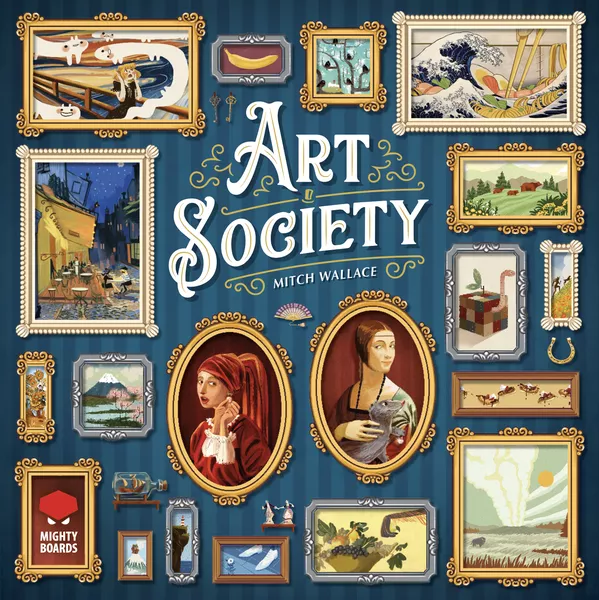
Today, we’re diving into “Art Society.” This is a board game that lets you step into the shoes of art collectors, competing to build the best-looking gallery. So, let’s break it down – what it is, what’s good, what’s bad, & if you should pick it up. Let’s get into it.
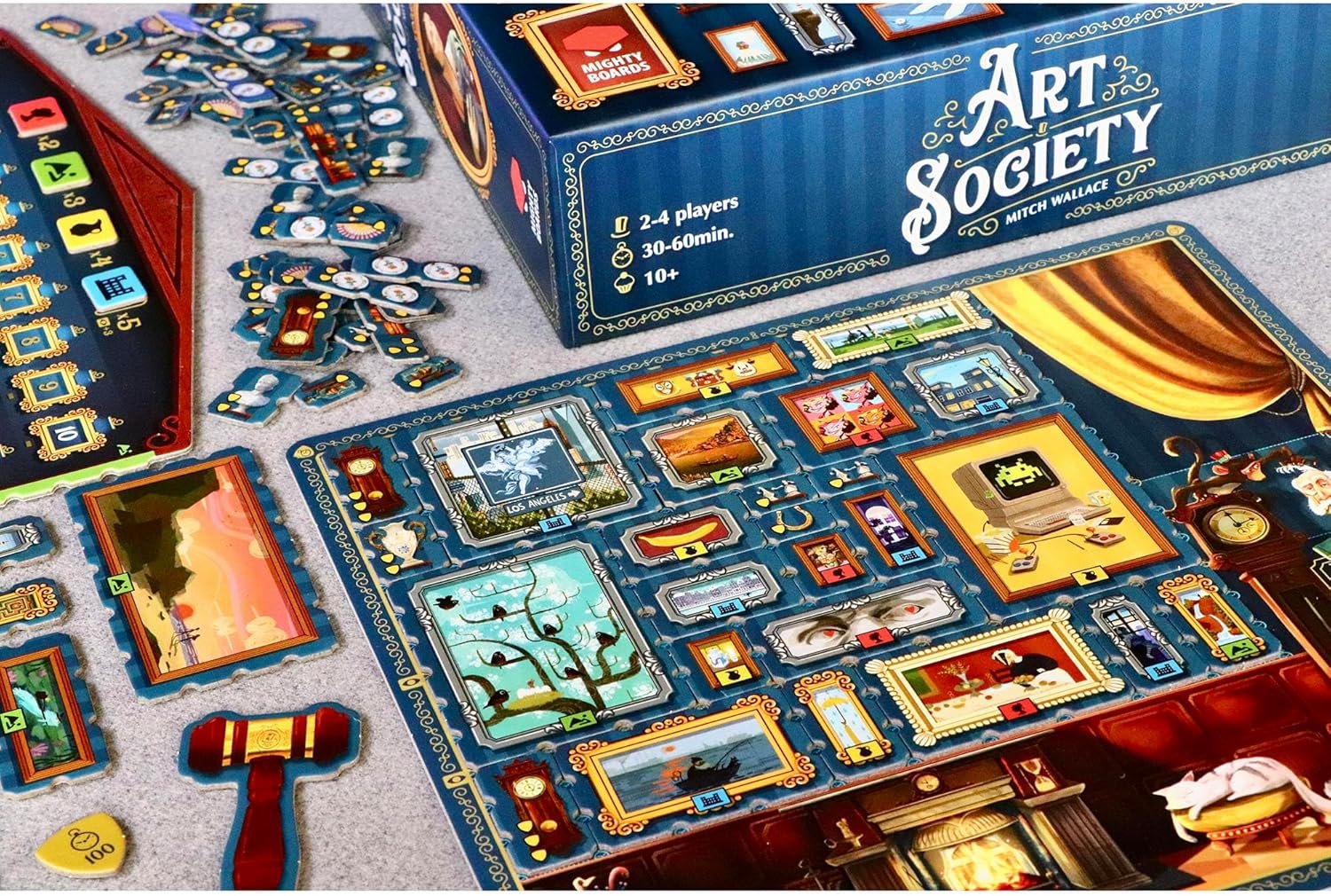
What It Is
Art Society is a competitive board game where players aim to build an impressive collection of art, hoping to end up with the most admired gallery. You’ll find elements of bidding, tile placement, & even a bit of puzzle-solving as you arrange your paintings. Set in a Victorian-style parlor, the game captures a mix of humor & charm with a quirky art selection that includes classical paintings, quirky modern pieces, & more. It’s all about managing your bids & gallery space effectively to outshine your fellow art connoisseurs.
Check Out These Recent Board Game Sales
- Board Game Sale: Disney Villainous 25% Off!
- Board Game Sale: Marvel: Crisis Protocol Core Set 30% Off!
- Board Game Sale: 7 Wonders Available for 17% Off!
Gameplay Overview
In Art Society, two to four players compete to curate the most prestigious art gallery, showcasing valuable pieces to earn admiration from their peers. Throughout the game, players participate in auctions, strategically bidding to acquire valuable art pieces that will shape their gallery displays & determine their success. The game begins with the setup of the Museum board at the center, with value tokens & Prestige markers placed nearby. Decor tiles, which players can earn later, are also set out for future rounds. Each player receives a player board, scoring markers, & a set of bidding cards numbered from 1 to 20.
To kick off the game, each player is given a starting painting to place in their gallery, following specific orientation rules for these pieces. Over 100 painting tiles are available, sorted by their values & shapes to ensure easy access. Each round’s auction starts with an auctioneer choosing paintings equal to the number of players plus one, with the paintings kept face-down to add a layer of strategic uncertainty. This mystery adds depth to bidding decisions, as players must consider their bids without fully knowing the value of the artwork up for grabs.
When bidding begins, players secretly choose a card from their hand & reveal it at the same time. The highest bidder selects a painting first, with the remaining players choosing in descending order. In case of a tie, additional cards are revealed until a single winner is decided. Any artwork not selected goes to the museum board, where it affects future rounds by impacting Prestige calculations, which represent a player’s rising status in the art world.
After selecting their paintings, players place these new acquisitions on their gallery walls, following strict orientation rules that require each piece to touch another along a flat edge. Strategic placement is essential, as the organization of the gallery will contribute significantly to end-game scoring. Additionally, players can earn Decor tiles when they place paintings with matching frames next to one another, which can further enhance the gallery’s visual appeal & boost their score.
To provide flexibility, players have access to an assistant mechanic, which allows them to temporarily store paintings or Decor tiles they are not ready to place in their gallery. This feature allows players to hold onto pieces they may strategically wish to deploy later, enhancing the game’s depth by enabling more complex planning & resource management.
Once all paintings are placed, players calculate any gained Prestige by moving markers on the Museum board, influenced by the unselected artworks from the auction. This step introduces a dynamic element, as each decision made impacts future rounds. The gavel token is then passed to the next player, who becomes the auctioneer, & the cycle continues until end-game conditions are met, such as players filling their gallery walls or depleting bidding cards.
At the game’s conclusion, players tally points based on their collected artwork & Decor tiles. Paintings are scored by color category, with players multiplying the number of paintings by their respective value on the Museum board. However, adjacency rules stipulate that touching paintings of the same type do not add to the score. Additional points are awarded for Decor tiles & bonuses for completing gallery spaces, while penalties are applied for any unfilled corners or unused paintings. With its unique blend of auction dynamics & spatial strategy, Art Society challenges players to balance bidding & gallery organization with artistic flair. As they compete for coveted art pieces, players discover new strategies to optimize their collections & placements, making each game session a fresh experience with plenty of opportunities for creative expression. The game delivers a mix of strategic depth & aesthetic enjoyment, capturing the essence of the art world within an engaging, competitive framework.
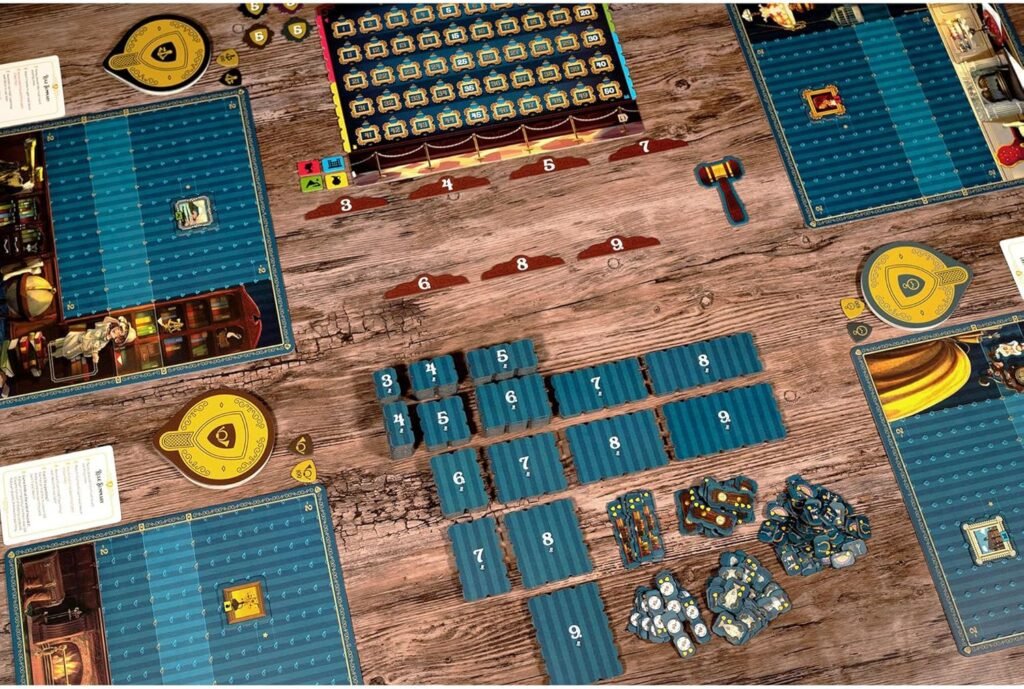
The Components
The game’s components are visually impressive. The board & tiles give off an old-timey art gallery vibe, with a fun mix of paintings ranging from traditional pieces to quirky modern touches that keep things interesting. The quality of the tiles, board, & cards is solid, & it’s clear the designers wanted to make this feel like a mini art gallery right on your table. Setup & teardown are straightforward, thanks to a well-designed storage system, which helps speed up playtime & makes it easy to bring to game night.
The Good
The theme in Art Society really shines. Building your own gallery, complete with a mishmash of art styles, is a fun concept that adds a bit of personality to each playthrough. It’s got that “something special” when you see your gallery come to life, & it’s a blast watching each player’s unique collection take shape over the game. The blend of auction mechanics with tile placement works well, & it’s satisfying to strategically outbid opponents & see your plans pay off in your gallery.
The bidding system is easy to grasp but keeps you guessing, as players must juggle their limited bid cards to get the pieces they want most. Each choice can shift the outcome of the game, making every round matter. The game plays fairly quickly, too, meaning you get a good amount of gameplay without it overstaying its welcome. Overall, it’s a nice mix of strategy & fun that brings new & experienced players together, making it a great choice for casual game nights.
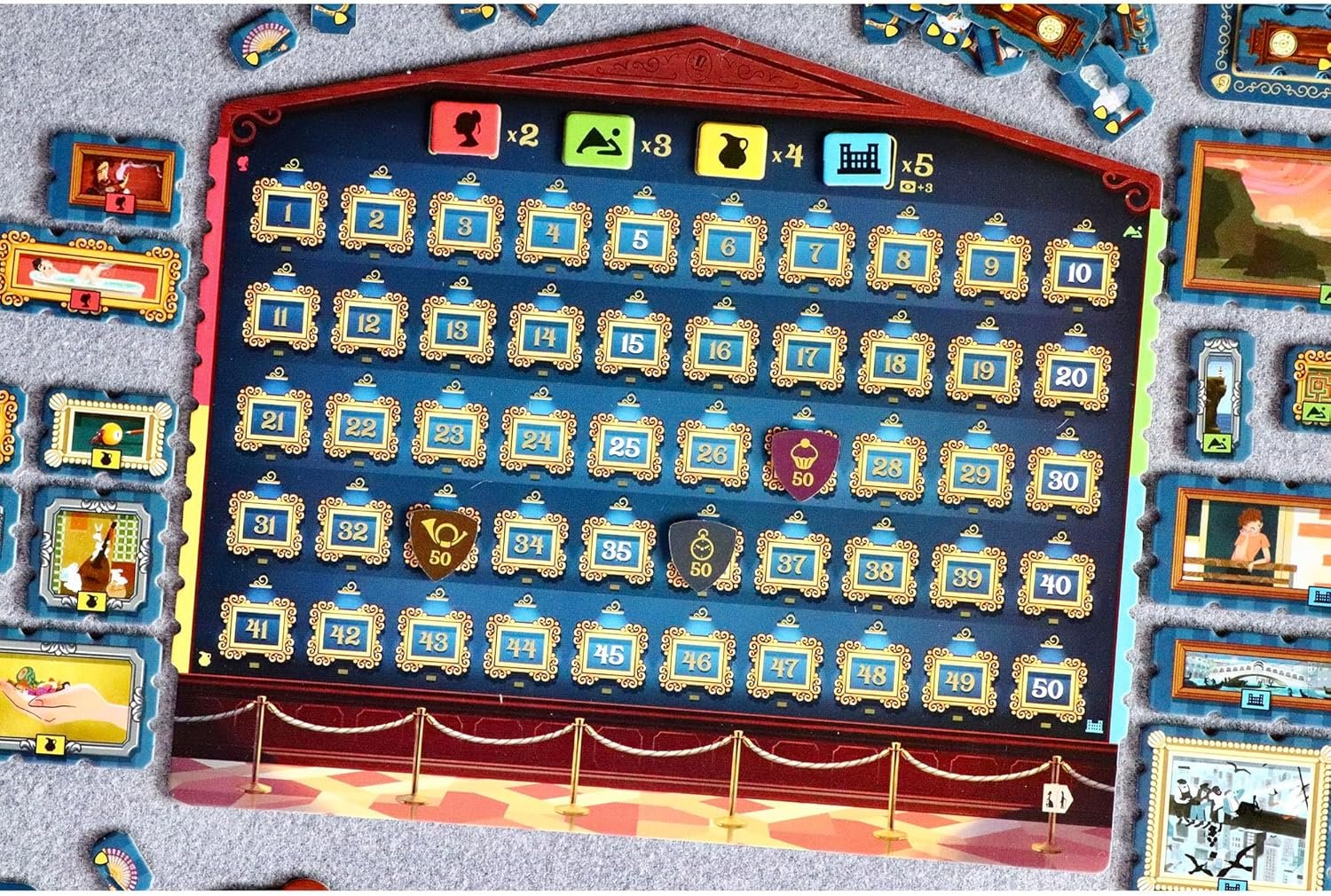
The Bad
That said, Art Society does have its hiccups. The scoring at the end can feel a bit random, with the prestige track shifting based on the leftover paintings. This can make it tough to plan long-term strategies, as the game’s value system changes on a whim. Some players find it frustrating when their well-planned gallery suddenly loses its edge due to a last-minute prestige shift. Regular scoring checkpoints could have helped alleviate this, giving players a better sense of where they stand as the game progresses.
Replay value might also be a concern for some. After a few sessions, the experience can start to feel repetitive, especially with the limited variety in scoring methods & the core gameplay loop. The setup is fun, but without much to shake up each playthrough, players who prefer lots of variety may find themselves wanting expansions or new rules to keep things fresh. & on a minor note, the odd tile sizes make placement a bit tricky at times, as you can’t always tell if a piece will fit without picking it up, which sometimes hints at your plans.
The Verdict
Art Society is a game that nails its theme & looks great while doing it. The Victorian art gallery aesthetic is charming, & the gameplay captures the thrill of collecting & bidding without bogging things down with complicated rules. For those who appreciate a quick game with a bit of strategy & enjoy the satisfaction of building their own collection, Art Society delivers a satisfying experience. Its simple auction mechanics combined with the puzzle of tile placement create a game that’s both engaging & easy to pick up.
However, it does come with a few limitations. The end-game scoring, while adding suspense, can feel like it undermines careful planning with its sudden shifts, leaving some players feeling a bit blindsided. Additionally, while it’s fun initially, the gameplay can start to feel a little “samey” after a few sessions, which might leave players wanting more ways to mix things up. Despite these drawbacks, Art Society is a solid choice for those looking for a visually appealing, light-to-medium-weight game with a fun theme.
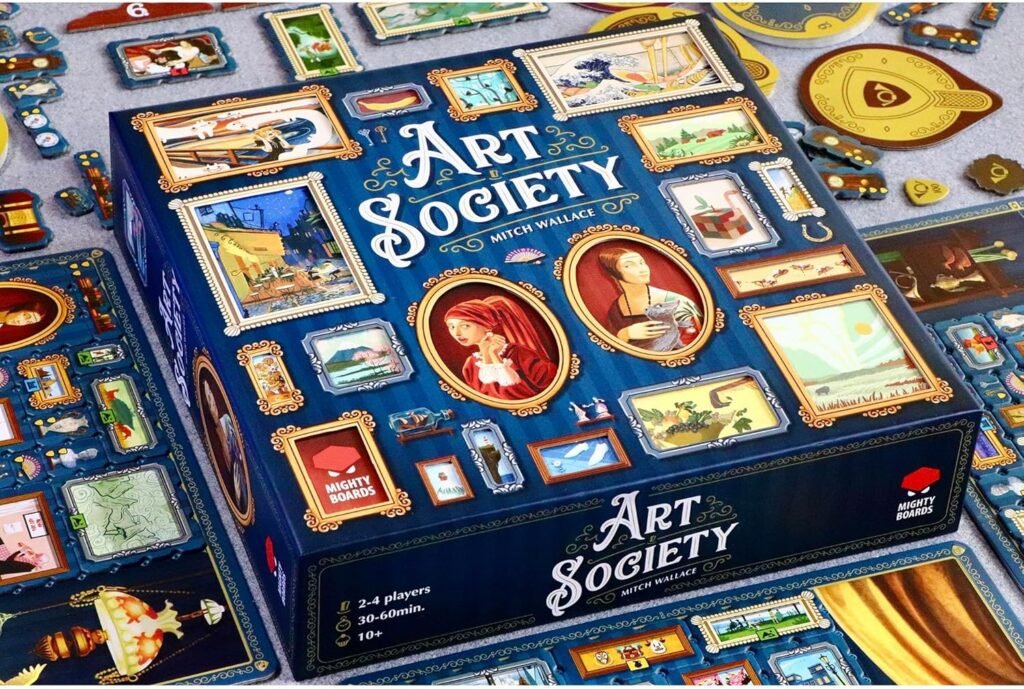
Final Thoughts
Alright, so let’s talk about Art Society. This game really surprised me with how much personality it packs into something as simple as building an art collection. Right from the start, the visual design is gorgeous—it has this rich, Victorian vibe that makes you feel like you’re walking into an eccentric art dealer’s parlor. The variety in the artwork alone brings a ton of humor & style to the game, blending classic pieces with quirky modern ones, so you’re constantly finding new things to laugh at or admire. It’s a game that doesn’t take itself too seriously, which is refreshing.
One of my favorite parts of playing Art Society is the bidding phase. The auction mechanics here are clever & have just enough depth to keep things interesting without dragging. You’re holding onto these numbered cards, deciding whether to throw in a high bid to grab a key piece or save it for later, & you’re always trying to keep track of what everyone else might do. The tie-breaking system adds a layer of strategy that makes every round feel like a small battle of wits, which I loved. It’s simple but satisfying & keeps everyone engaged.
Then there’s the gallery-building part, which adds this fun spatial puzzle element. You’re not just collecting art but trying to arrange it in a way that maximizes your points while avoiding penalties, & it adds a lot of tension in a good way. There’s something very satisfying about fitting each piece into your gallery, almost like curating your own mini-museum. This part feels less competitive & more personal, which is nice since you’re mostly focused on your own layout, & it gives you a break from the auction intensity.
That said, I do have a couple of nitpicks. The end-game scoring feels a bit out of left field because of the prestige track, which can shift in ways that are hard to predict. You could have a collection you’re really proud of, only to find out that certain pieces suddenly aren’t worth as much, which can be a little frustrating. I’d love it if the game provided a more steady way to track points, but it’s a minor quibble & doesn’t overshadow the whole experience.
I also wonder about the game’s replay value. It’s definitely fun, but once you get the hang of it, it doesn’t change much from game to game. For casual groups, this might be a perfect fit, but if you’re someone who likes a bit more variety, you might find yourself wishing for expansions with new goals or maybe some unique player powers to shake things up. Still, I think it’s a game I’ll keep coming back to whenever I want something visually beautiful that doesn’t demand a ton of focus but is still strategic.
Overall, I’d say Art Society is a gem, especially if you’re looking for something with a unique theme & charming aesthetic. The mix of bidding & tile placement works well, & the quirky art makes it feel like you’re building a collection that’s genuinely yours. It’s easy to teach, easy to play, & a great choice for a laid-back game night with friends or family. It’s not going to be everyone’s all-time favorite, but it’s one of those games that does what it sets out to do really well, & sometimes that’s exactly what you need.
Purchase Options

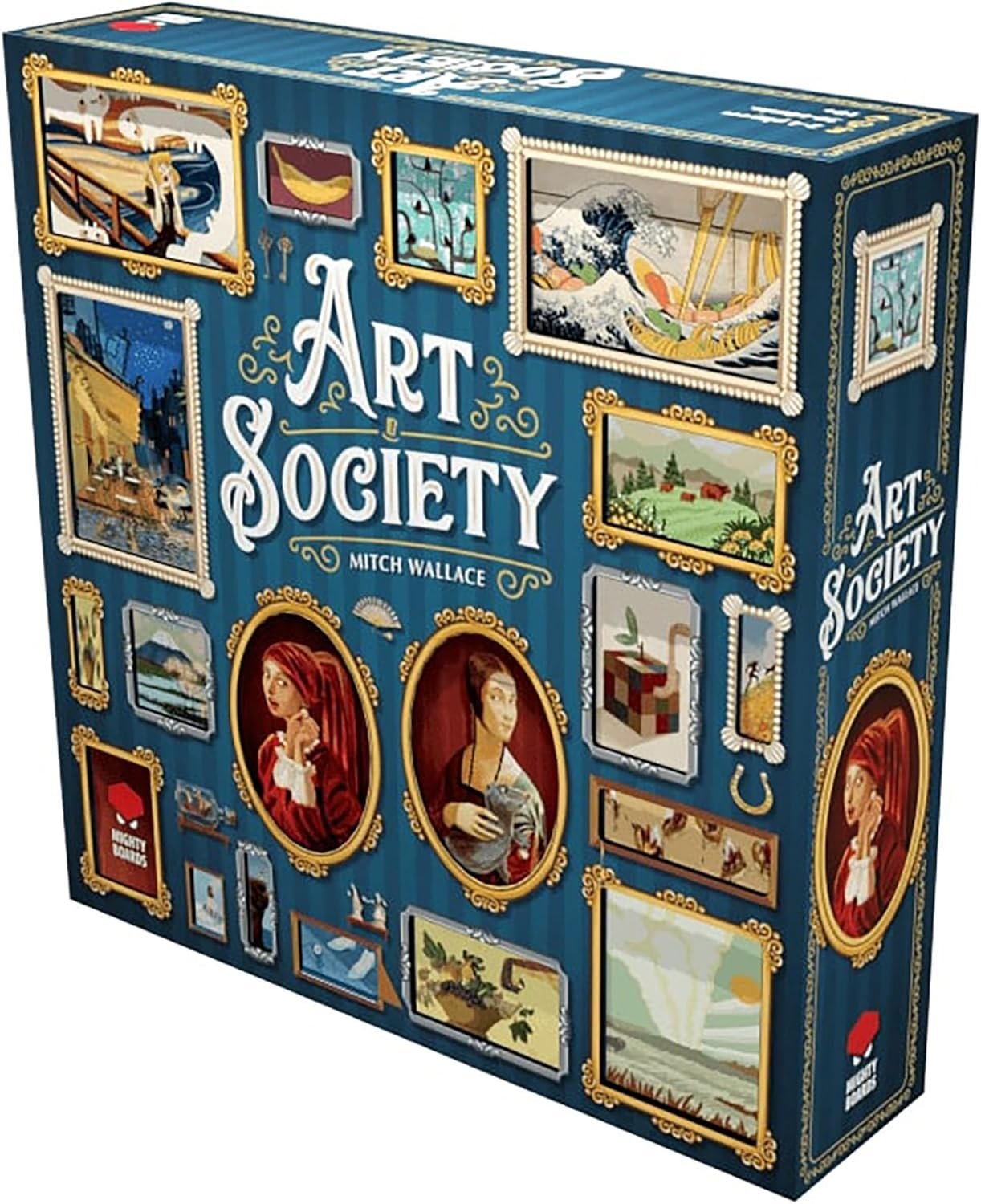
At no extra cost to you, The Board Game Site may receive revenue from affiliate and advertising partnerships for sharing this content and from purchases through links.








